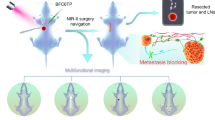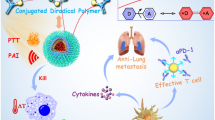Abstract
The present study describes a development of nanohydrogel, loaded with QD705 and manganese (QD705@Nanogel and QD705@Mn@Nanogel), and its passive and electro-assisted delivery in solid tumors, visualized by fluorescence imaging and magnetic resonance imaging (MRI) on colon cancer-grafted mice as a model. QD705@Nanogel was delivered passively predominantly into the tumor, which was visualized in vivo and ex vivo using fluorescent imaging. The fluorescence intensity increased gradually within 30 min after injection, reached a plateau between 30 min and 2 h, and decreased gradually to the baseline within 24 h. The fluorescence intensity in the tumor area was about 2.5 times higher than the background fluorescence. A very weak fluorescent signal was detected in the liver area, but not in the areas of the kidneys or bladder. This result was in contrast with our previous study, indicating that FITC@Mn@Nanogel did not enter into the tumor and was detected rapidly in the kidney and bladder after i.v. injection [J. Mater. Chem. B 2013, 1, 4932–4938]. We found that the embedding of a hard material (as QD) in nanohydrogel changes the physical properties of the soft material (decreases the size and negative charge and changes the shape) and alters its pharmacodynamics. Electroporation facilitated the delivery of the nanohydrogel in the tumor tissue, visualized by fluorescent imaging and MRI. Strong signal intensity was recorded in the tumor area shortly after the combined treatment (QD@Mn@Nanogel + electroporation), and it was observed even 48 h after the electroporation. The data demonstrate more effective penetration of the nanoparticles in the tumor due to the increased permeability of blood vessels at the electroporated area. There was no rupture of blood vessels after electroporation, and there were no artifacts in the images due to a bleeding.

ᅟ







Similar content being viewed by others
References
Bakalova R, Zhelev Z, Aoki I, Kano I (2007) Designing quantum dot probes. Nat Photonics 1:487–489
Janib JA, Moses SM, MacKey AS (2010) Imaging and drug delivery using theranostic nanoparticles. Adv Drug Deliv Rev 62:11
Kokuryo D, Nakashima S, Ozaki F, Yuba E, Chuang KH, Aoshima S, Ishizaka Y, Saga T, Aoki I (2015) Evaluation of thermo-triggered drug release in intramuscular-transplanted tumors using thermosensitive polymer-modified liposomes and MRI. Nanomedicine 11:229–238
Christian DA, Cai S, Bowen DM, Kim Y, Pajerowski JD, Discher DE (2009) Polymersome carriers: from self-assembly to siRNA and protein therapeutics. Eur J Pharm Biopharm 71:463–474
Lrvine DH, Ghoroghchian PP, Freudenberg J, Zhang G, Therien MJ, Greene MI, Hammer DA, Mirali R (2008) Polymersomes: a new multi-functional tool for cancer diagnosis and therapy. Methods 46:25032
Baeza A, Colilla M, Vallet-Regi M (2015) Advances in mesoporous silica nanoparticles for targeted stimuli-responsive drug delivery. Expert Opin Drug Deliv 12:319–337
Murayama S, Nishiyama T, Takagi K, Ishizuka F, Santa T, Kato M (2012) Devilevry, stabilization, and spatiotemporal activation of cargo molecules in cells with positively charged nanoparticles. Chem Commun (Camb) 48:11461–11463
Murayama S, Su B, Okabe K, Kishimura A, Osada K, Miura M, Funatsu T, Kataoka K, Kato K (2012) NanoPARCEL: a method for controlling cellular behaviour with external light. Chem Commun (Camb) 48:8380–8382
Murayama S, Jo J, Shibata Y, Liang K, Santa T, Saga T, Aoki I, Kato M (2013) The simple preparation of polyethilene glykol-based soft nanoparticles containing dual imaging probes. J Mater Chem B 1:4932–4938
Neumann E, Shaeffer-Rider M, Wang Y, Hofschnaider P (1982) Gene transfer into mouse lyoma cells by electroporation in high electric fields. EMBO J 1:841–845
Tsoneva I, Iordanov I, Berger A, Nikolova B, Tomov T, Mudrov N, Berger MR (2010) Electrodelivery of drugs into cancer cells in the presence of poloxamer 188. J Biomed Biotechnol
Rodriguez-Devora JI, Ambure S, Shi Z-D, Yuan Y, Sun W, Xu T (2012) Physically facilitating drug-delivery systems. Ther Deliv 3:125–139
Dotsinski I, Nikolova B, Peycheva E, Tsoneva I (2010) New modality for electrochemotherapy of surface tumors. Biotechnol Biotechnol Equip 26:3402–3406
Yarmush ML, Golberg A, Sersa G, Kotnik T, Miklavcic D (2014) Electroporation-based technologies for medicine: principles, applications, and challenges. Annu Rev Biomed Eng 16:295–320
Sapsford KE, Algar WR, Berti L, Gemmill KB, Casey BJ, Oh E, Stewart MH, Medintz IL (2013) Functionalizing nanoparticles with biological molecules: developing chemistries that facilitate nanotechnology. Chem Rev 113:1904–2074
Cai W, Chen K, Li ZB, Gambhir SS, Chen X (2007) Dual-function probe for PET and near-infrared fluorescence imaging of tumor vasculature. J Nucl Med 48:1862–1870
Langereis S, Geelen T, Grull H, Strijkers GJ, Nicolay K (2013) Paramagnetic liposomes for molecular MRI and MRI guided drug delivery. NMR Biomed 26:728–744
Bakalova R, Lazarova D, Nikolova B, Atanasova S, Zlateva G, Zhelev Z, Aoki I (2015) Delivery of size-controlled long-circulating polymerzomes in solid tumors, vizualized by quantum dots and optical imaging in vivo. Biotechnol Biotechnol Equip 29:175–180
Erickson HP (2009) Size and shape of protein molecules and the mamometer level determined by sedimentation, gel filtration, and electron microscopy. In: “Biological Procedures Online” (Shullin Li, ed.), Vol. 11, No. 1, pp. 32-51
Sersa G, Krzic M, Sentjurc M, Ivanusa T, Beravs K, Kotnik V, Coer A, Swartz HM, Cemazar M (2002) Reduced blood flow and oxygenation in SA-1 tumours after electrochemotherapy with cisplatin. Br J Cancer 87:1047–1054
Gehl J, Skovsgaar T, Mir L (2002) Vascular reaction to in vivo electroporation: characterization and consequences for drug and gene delivery. Biochem Biophys Acta 1569:51–58
Peycheva E, Daskalov I, Tsoneva I (2007) Electrochemotherapy of Mycosis fungoides by interferon-α. Bioelectrochemistry 70:283–286
Murayama S, Kato M (2010) Photocontrol of biological activities of protein by means of a hydrogel. Anal Chem 82:2186–2191
Aoki I, Yoneyama M, Hirose J, Minemoto Y, Koyama T, Kokuryo D, Bakalova R, Murayama S, Saga T, Aoshima S, Ishizaka Y, Kono K (2015) Thermoactivatable polymer-grafted liposomes for low-invasive image-guided chemotherapy. Transl Res [E-pub: August 6]
Huang S, Deshmukh H, Rajagopalan KK, Wang S (2014) Gold nanoparticles electroporation enhanced polyplex delivery to mammalian cells. Electrophoresis 35:1837–1845
Zu Y, Huang S, Liao WC, Lu Y, Wang S (2014) Gold nanoparticles enhanced electroporation for mammalian cell transfection. J Biomed Nanotechnol 10:982–992
Boukany PE, Wu Y, Zhao X, Kwak KJ, Glazer PJ, Leong K, Lee LJ (2014) Nonendocytic delivery of lipoplex nanoparticles into living cells using nanochannel electroporation. Adv Healthc Mater 3:682–689
Hobo W, Novobrantseva TI, Fredrix H, Wong J, Milstein S, Epstein-Barash H, Liu J, Schaap N, van der Voort R, Dolstra H (2013) Improving dendritic cell vaccine immunogenicity by silencing PD-1 ligands using siRNA-lipid nanoparticles combined with antigen mRNA electroporation. Cancer Immunol Immunother 62:285–297
Yoo J, Won N, Kim H, Bang J, Kim S, Ahn S, Soh K (2010) In vivo imaging of cancer cells with electroporation of quantum dots and multispcetral imaging. J Appl Phys 107:124702
West DL, White SB, Zhang Z, Larson AC, Omary RA (2014) Assessment and optimization of electroporation-assisted tumoral nanoparticle uptake in a nude mouse model of pancreatic ductal adenocarcinoma. Int J Nanomedicine 9:4169–4176
Nanda GS, Sun FX, Hofmann GA, Hoffman RM, Dev SB (1998) Electroporation enhances therapeutic efficiency of anticancer drugs: treatment of human pancreatic tumor in animal model. Anticancer Res 18:1361–1366
Bennet KM, Jo J, Carbral H, Bakalova R, Aoki I (2014) MR imaging techniques for nanopathophysiology and theranosctics. Adv Drug Deliv Rev 74:75–94
Saito S, Hasegawa S, Sekita A, Bakalova R, Furukawa T, Murase K, Saga T, Aoki I (2013) Manganese-enhanced MRI reveals early-phase radiation-induced cell alterations in vivo. Cancer Res 73:3216–3224
Acknowledgments
The authors thank Ms. Sayaka Shibata (Molecular Imaging Center, National Institute of Radiological Sciences, Japan) for her assistance during the experiments in vivo, Mr. Yoshikazu Ozawa for his assistance during the MRI measurements, and the One-stop Sharing Faculty Center for Future Drug Discoveries in the University of Tokyo for AFM measurements. The study was partially supported by the Ministry of Education, Science and Technology of Japan (Grant-in-Aid “Kakenhi” to R.B. and S.M., and JSPS Fellowship to B.N.) and conducted by the EU-COST Action TD1104.
Author information
Authors and Affiliations
Corresponding author
Ethics declarations
Author contributions
R.B., Z.Z., and I.A. designed the study; B.N., S.A., S.M., and M.K. performed the experiments; R.B., B.N., and S.A. analyzed the data; R.B. and B.N. wrote the manuscript; and Z.Z., I.T., and T.S. revised the manuscript.
Conflict of interest
The authors report no conflicts of interest in this work.
Electronic supplementary material
Below is the link to the electronic supplementary material.
ESM 1
(PDF 3.35 MB)
Rights and permissions
About this article
Cite this article
Bakalova, R., Nikolova, B., Murayama, S. et al. Passive and electro-assisted delivery of hydrogel nanoparticles in solid tumors, visualized by optical and magnetic resonance imaging in vivo. Anal Bioanal Chem 408, 905–914 (2016). https://doi.org/10.1007/s00216-015-9182-4
Received:
Revised:
Accepted:
Published:
Issue Date:
DOI: https://doi.org/10.1007/s00216-015-9182-4




